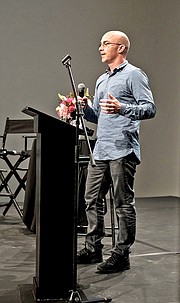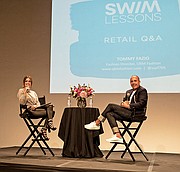EVENTS
UBM Brings Swim Lessons Back to LA
Early in BB Dakota’s history, the brand was picked up by the juniors buyer from a major department store—even though the Costa Mesa, Calif.–based company didn’t consider the brand a juniors label.
“In our heads we were a contemporary brand,” said Gloria Brandes, BB Dakota’s chief executive officer and creative director.
When the same buyer moved to the department store’s contemporary buying team, she wanted to take the brand with her, Brandes said. At the MAGIC trade show in Las Vegas, the buyer placed an order for BB Dakota for the store’s contemporary floor. But when the store’s new juniors buyer arrived in the booth, Brandes had to do some quick thinking.
“We said, ‘We still have this part of the brand available,’” she said. “And that became Jack by BB Dakota. At MAGIC is where we split up the label. It really determined that BB Dakota is cotemporary and Jack is juniors.”
Brandes told that story to a crowd of about 100 fashion executives and entrepreneurs at a June 8 event organized by UBM Fashion, the parent company of apparel trade shows MAGIC, Project and Coterie. This was the second time UBM hosted its Swimlessons program in Los Angeles. Brandes shared the program with Kim Johnson, the former chief operating officer at Drifter; Tim Moore, the executive vice president of Hilldun Corp.; and Syama Meagher, the chief executive officer of Scaling Retail. (The author was among the panelists as well.) Chelsea Matthews, founder and executive creative director of Matte Black, served as the event moderator.
These days, BB Dakota is carried in about 1,200 accounts, Brandes said, including the core boutique base, where the brand got its start.
“We spent years in boutiques building that account base,” Brandes said. “It’s very solid and they’ve very loyal. If their credit holds, they’re a great place to start and they really showcase brands.”
The line is also carried in majors such as Nordstrom, Bloomingdale’s and Lord & Taylor. Two years ago, the company partnered with the lifestyle blog “Cupcakes and Cashmere.”
“We thought that was a match made in heaven,” Brandes said, adding that “Cupcakes and Cashmere” founder Emily Schuman and her husband and business partner, Geoffrey Fuller, proved to be a good fit with BB Dakota.
“Emily and her husband are very savvy,” Brandes said. “They understand how to market and she believes in what she does and her product.”
Still, Brandes said, BB Dakota is not looking to build a stable of blogger-licensed brands.
“We want to focus on our own brands,” she said. “Emily was something special.”
The company recently launched a new social-occasion line called RSVP.
Moore, the executive vice president with Hilldun, walked the crowd through several financing options, including production financing and receivables financing, or factoring. He also discussed the growing popularity of another kind of financing merchant, advance financing, which is popular with e-commerce sites and other businesses that do much of their business with credit cards. Under this method, Hilldun will look at a company’s monthly credit-card receipts and the monthly shipping quantities to determine a line of credit based on multiple months of projected shipping.
Scaling Retail’s Meagher outlined a few emerging trends in retail, including co-retailing, in which a company will rent space within an existing retailer.
“What you get in exchange depends on the retailer,” she said, pointing to examples such as Wolf and Badger and Dreams on Air, both in New York.
“Think about these spaces as marketing opportunities for your company,” she said. “It allows you to test out things like price-point sensitivity. [But] you cannot count on these spaces to be a retail-sales generator for growth.”
Meagher also suggested attendees look into the practice of “see now, buy now.” For a small company, that might mean a capsule collection that is immediately available for purchase.
Another option is “social selling” on mobile-technology platforms such as Villoid.
“As retail is evolving, your consumer is evolving,” she said. “Retail is not dead. It is just changing. It takes four to six touch points to make a consumer brand loyal.”
During the Q&A session following Meagher’s presentation, one attendee asked about marketing budgets. Meagher recommended channeling 30 percent of a company’s profits back into marketing.
The event also included Q&A sessions with UBM executives, including UBM Fashion Director Tommy Fazio.
Before joining UBM, Fazio’s career included stints at Diesel, DKNY, Calvin Klein, Neiman Marcus and Bergdorf Goodman. He gave the audience insight into the mind of a retailer.
“We all want to be first. We all want the exclusive,” he said.
Fazio suggested sending brand books to buyers because they can be “a pre-shop for retailers.”
Once at the show, he suggested keeping merchandising simple.
“When it comes to merchandising, less is more,” he said. Show me your best 10 styles—your best five even—that’s your conversation.”
























